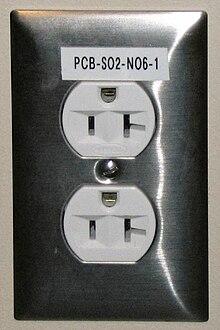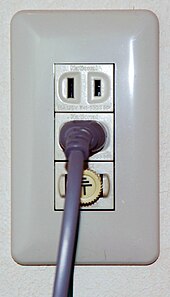NEMA 5-15 (15 A/125 V earthed) (Type B)
NEMA 5-15 plug, left. Decorative-style duplex socket, center. Ordinary duplex socket, right. Photos are different scale – parallel blades are on 1/2 inch (12.7 mm) centers.
The NEMA 5-15 plug has two flat parallel blades like NEMA 1-15, but also adds an earthing blade.It is rated 15 A at 125 volts. The earth pin is longer than the line and neutral blades, so the device is earthed before the power is connected. Both current-carrying blades on earthing plugs are narrow, since the earth pin enforces polarity. NEMA 1-15 plugs are also compatible with NEMA 5-15 sockets.
The 5-15 socket is standard in Canada, the United States, Mexico and Panama. It is also used in Central America, the Caribbean, northern South America (Colombia, Ecuador, Venezuela and, as a legacy, parts of Brazil), Japan, Taiwan, the Philippines and Saudi Arabia. This socket is recommended in IEC standard 60906-2 for 120 volt 60 Hz installations. Looking directly at a NEMA 5-15 socket with the earth at the bottom, the neutral slot is on the left, and the line slot is on the right. Sockets may be installed in any orientation.
In some parts of the United States and all of Canada, tamper-resistant sockets are now required in new residential construction. These prevent contact by objects like keys or paper clips inserted into the socket.
In stage lighting, this connector is sometimes known as PBG for Parallel Blade with Ground (earth), Edison or Hubbell, the name of a common manufacturer.
[edit] NEMA 5-20 (North American 20 A/125 V earthed)

5-20RA (Canada) or 5-20R (USA) T-slot socket mounted with the earth hole up. The neutral connection is the wider T-shaped slot on the right
This is a 20 A socket. The NEMA 5-20 A variant has a T-slot for the neutral blade which accepts either 15 A parallel-blade plugs or 20 A plugs.
NEMA 14-30
A 30 A, 3 wire single-phase earthing socket is often used for electric clothes dryers. 240 volts from the split phase system is used for the heating elements, and the motor and controls run on 120 volts. These plugs have blades that are rather larger than NEMA 5-20, are more widely spaced, and are angled so as to prevent using the wrong plug in the wrong circuit.
NEMA 14-50
A 50 A 3 wire single-phase earthing socket is usually installed in kitchens and used for electric cooking ranges and ovens. As for dryers, lighting and motors run on 120 V and the main heating element is connected for 240 V. Many plug-in electric cars use this type of socket for recharging in the owner’s garage.
JIS C 8303, Class II (Japanese 15 A/100 V unearthed)

Japanese socket with earth post, for a washing machine
The Japanese plug and socket appear physically identical to NEMA 1-15. The Japanese system incorporates stricter dimensional requirements for the plug housing, different marking requirements, and mandatory testing and approval by METI or JIS.
Older Japanese sockets and multi-plug adapters are unpolarized — the slots in the sockets are the same size — and will accept only unpolarized plugs. Japanese plugs generally fit into most North American sockets without modification, but polarized North American plugs may require adapters or replacement non-polarized plugs to connect to older Japanese sockets. In Japan the voltage is 100V, and the frequency is 50 Hz (East Japan) or 60 Hz (West Japan). Therefore, some North American devices which can be physically plugged into Japanese sockets may not function properly.
JIS C 8303, Class I (Japanese 15 A/100 V earthed)
Japan also uses an unearthed plug similar to the North American NEMA 5-15. However, it is less common than its NEMA 1-15 equivalent. Since 2005, new Japanese homes are required to have class I earthed sockets for connecting domestic appliances. This rule does not apply for sockets not intended to be used for domestic appliances, but it is strongly advised to have class I sockets throughout the home.
Maybe you like to know Plug type for every country
|





